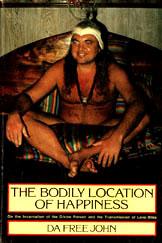The Devi and Shakti

“I’ve Established Myself here and made it possible for My Own Work to be effective forever and, in some sense then, the Goddess is as deluded as it ever was. No matter how many holes are in it now, it’s just as much an illusion and just as powerful in its ability to deluded, just as powerful as an illusion as it ever was. I couldn’t make enough holes in it to eliminate the force of the deluding power of the presumed separate universe. It is only by Intruding, Spiritually, into the very fabric of My devotee’s own presumed manifestation of body-mind, that I Relieve My devotee of the illusion of his or her own presumptions.”

He-AND-She Is Me
The Seventeen Companions of the True Dawn Horse
Book Seven
***
Bubba Free John (Adi Da Samraj) Talking with devotee (Terry Patten) – April 18, 1974
The Devi and the Shakti
Bubba: The Shakti only seeks to fascinate and that’s the end in itself. The Shakti always binds you to phenomena. The Devi has only phenomena to operate through because that is the form of her manifestation but she serves the Lord. So, she creates changes, dramas, theatre in order to undermine the bondage of individuals to theatre. So, all of the exotic things you see me do are the play of the Devi.
The function of the Heart, the Guru function in itself is silent, moveless, and doesn’t really make an impression. It makes an impression in an extremely subtle sense in the force of Satsang. It is a conscious intensity that is not the same as Shakti. It may be known but doesn’t have theatre connected with it. It is like a siva lingum.

The Devi is full of movement, but she serves the Divine. The Shakti has nothing whatever to do with my work. She is an obstacle to the work and she is present in the form of disciples and devotees. Not really in devotees when they truly exist, but she is present in those who are in the community in the form of their bondage, their cultic tendencies, their whole life of tendencies.

So, the Devi is always waring with the Shakti in order to bring about Divine realization, in order to return people to Satsang, which is symbolically represented by individuals sitting around a stone, in which there is no movement, in which there is no apparent communication, no consolations given, there is not fascination.
Devotee: So, that real sacrifice when it is absolutely constant is constant. It isn’t just constant motion of sacrifice which is what we tend to experience.
Bubba: No. The sacrifice is a perfect event, so it really doesn’t have any drama associated with it. But the demand for sacrifice is made through movement, through theatre, through the instrumentality of the Devi or the Devi function.
There may come a time when there is some person who will manage this theatre just as I do. It is not really very likely but is a possibility. It really would require something else from a person. But it would be very nice. It is not necessary. It just externalizes the theatre in another way. It creates the lessons in another way. The function is already here so it is not like an absolute necessity It is just another bit of humor.
In fact, the Ashram itself becomes the Devi, the Ashram itself becomes the movement of the Guru. That is why the Ashram is what remains behind after his death, the Guru returns to his ultimate function which is moveless and without apparency at death, just as that was truly where he was in life, but at the point of his death, it seems to become apparent. At least you have no other resort.
But then the Ashram of devotees takes on the extended function of the Guru, becomes the Devi form and becomes responsible then for creating the theatre that serves the Divine, that breaks down the bondage to the Goddess, the Shakti, and return individuals to the Heart, to the Divine intuition.
***

***
“I again lay down to sleep on the floor in the Master’s residence, this time in the living room. As the
house became quiet, I fell asleep, but I was awakened by a feeling that someone was trying to shake me
awake. I opened my eyes and in the dark room I saw the Devi again, this time standing on a small
table and brandishing a sword. But she was not alone-a small radiantly bluish male figure stood
facing her, also holding a sword in one upraised arm They shone with a blue glow of light.
I watched the play of the Siva and Shakti for a few minutes, blissfully happy to have sight of them.
They stood in the attitude of combatants, but their poses seemed symbolic. They did not strike at one another, but their bodies swayed slightly in ecstatic rhythm. I closed my eyes and went to sleep.”
The Bodily Location of Happiness, p. 233-234
